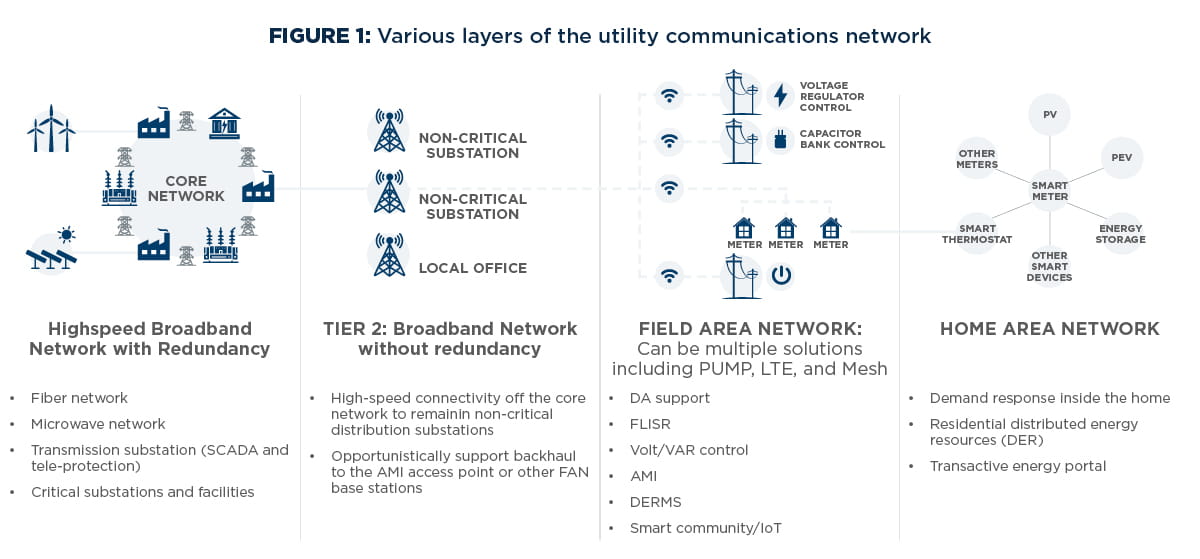
July 2019 | Point of View
The future of the utility field area network
Smart Grid devices and technologies are being deployed by utilities across the country to improve operational efficiency, reliability, security, and resilience
The future of the utility field area network
As utilities deploy increasingly more managed devices onto their transmission and distribution systems, there is an ever-growing need for a more reliable, secure, and interoperable communication network. This is where the need for a robust communication system comes into play. The field area network (FAN) is arguably the most complex piece of the communications network, since it is primarily responsible for providing “last-mile” communications to end-devices. Until recently, FANs were deployed to serve a limited purpose—for example, only for distribution automation (DA) or substation automation (SA). Today, we must think beyond DA and SA. A more expansive use of the FAN, as it relates to other layers of utility telecommunications, is displayed in Figure 1.
Realizing the Benefit of Fan
With the ability of the field area network to communicate directly with Smart Grid devices, a FAN is a critical component in enabling the benefits of grid-modernization programs to be realized. A FAN will also reduce the utility’s outage frequency and duration, enhance security, improve grid visibility, and provide better integration of distributed energy resources.
Real-time communications are also critical to “self-healing” networks, with many of the modern-day FAN technologies using machine learning and advanced algorithms to prevent, and more quickly energize after, an event. Additionally, a FAN gives utilities the capability to perform more advanced diagnostics to identify equipment issues in the field. For example, during an outage event, rather than dispatching a crew to troubleshoot, a FAN can be used to diagnose an issue remotely and send the appropriate crew to the correct location equipped to fix the issue on the spot.
Worldwide, it is estimated that utilities will be managing more than 1.5 billion devices on their networks by 2020, up from about 485 million in 2013.2 Additionally, utilities are projected to spend close to $100 billion on networking and communications equipment and support services over the next 10 years.
With an increasing number of use cases, many utilities have expanded their FANs to support new devices, which can impact system availability and reliability. Expanding a FAN to support more use cases it was not originally designed for can also require investing in additional base stations and reconfiguring the network architecture.
Forecasting Technology Needs Challenge for Utilities
Utilities are seeing greater diversity in connected devices, with many of them supporting systems like advanced metering infrastructure (AMI); fault location, isolation and system restoration (FLISR); Volt/VAR optimization (VVO); distributed energy resource management systems (DERMS); and smart community applications (Figure 2). The wide variety of devices includes reclosers, faulted circuit indicators, line sensors, capacitor banks, smart fuses, voltage regulators, smart inverters, distributed energy resources (DERs), large electric vehicle (EV) charging stations, rural internet access, and a myriad of sensors.
The diversity of devices supported by FANs poses a challenge with different physical interfaces, transport technologies, and back-end applications, with each type having its own set of requirements and constraints, such as bandwidth, frequency of polling, amount of available space, and available power supply.
A challenge to utilities is to select the most appropriate technology to serve their needs over the next 10–15 years. To facilitate this discussion, we have broken up FAN evaluation and selection into a three-step process:
- Identify grid-modernization challenges and opportunities.
- Evaluate technology options: cellular, Long-Term Evolution (LTE), mesh, licensed vs. unlicensed, PSBM.
- Evaluate hardware and vendor options. Each step is discussed further below.
Step 1: Identify grid-modernization challenges and opportunities
Some technologies, including 3G wireless and leased lines, are being retired, while others, like multiple address systems (MASs) deployed in the 1990s, are becoming obsolete. Although there are significant portions of existing MAS infrastructure that remain critical, most of the technology in place is no longer supported by manufacturers and has, effectively, reached end-of-life. Overall, utilities are moving beyond simple visibility and control of remote sites due to many of the reasons mentioned earlier. Internet protocol (IP) connectivity has also become an increasingly important component of many utility telecommunications and FAN strategies to ensure the network is built using the latest industry standards, providing the most flexibility for future device support.
Cybersecurity, physical security, and the potential for hacking or interruption of service have all grown in importance. While simple connectivity, such as using leased lines or MAS, was adequate 30–40 years ago, there are a growing number of use cases and applications, such as snapshot file download, remote firmware updates, and even video surveillance, that are becoming the standard industry expectation at remote sites.



